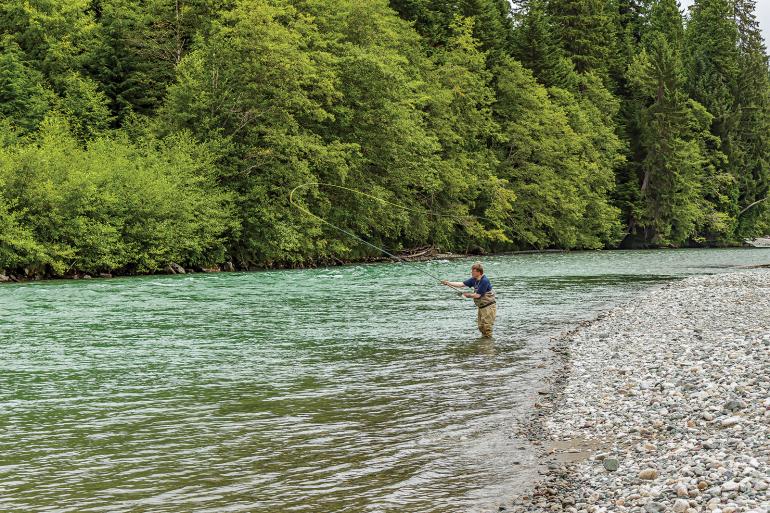Trending Techniques
The lowdown on Euro nymphing and trout spey.
Fly fishing is a booming business these days. And with all the gizmos and specialized gear being sold, it’s easy to forget how much can actually be done with a standard nine-foot, five-weight rod. Using a basic rod-and-reel setup, there are a handful of fun, alternative techniques that an angler can employ: two of my favorites being European “euro” nymphing, and trout spey. Euro nymphing involves running heavy flies on a tight line, while trout spey spawns from two-handed casting methods commonly used for salmon and steelhead. Adding elements from these two techniques to your repertoire can make you a more versatile angler without buying new gear.
Euro Nymphing
This refers to fishing nymphs without a suspension device, like a strike indicator or bobber. Indicators, while useful, create slack between the rod and fly, making strike detection slow and less reliable. They also make a disturbance on the water, which can spook fish.
When euro nymphing, on the other hand, you are in touch with your fly for the entirety of a drift. The in-touch angler can feel when his fly ticks a rock, and when the fly is pulled, pushed, or lifted by micro-currents. He can reliably feel the exact moment when a fish takes the bait—provided he keeps the line tight, of course.
To set up a euro rig on your five-weight fly rod, you’ll want to negate the fly line entirely. Fly line is thick and heavy, and it sags from the tip of the rod when held off the water. This makes tight-line presentations far more difficult, and hinders strike-detection considerably. Monofilament line, on the other hand, is thin and light, and sags far less. This might not be conventional “fly fishing,” but the goal is to catch fish, and if you can set aside notions of traditional “fly line,” then follow along.
To make a euro-nymphing leader, attach about 30 feet of 20-pound Maxima Chameleon to the end of your fly line. To the Chameleon, attach a two-foot section of brightly-colored red or yellow monofilament as your “indicator.” It should be somewhere in the neighborhood of 2X tippet or 10lb test.
Then, if only rigging for one fly, attach two to four feet of tippet and tie a heavy nymph on the end. If fishing two flies, add on an additional two feet of slightly lighter tippet, leaving a long tag end (about six inches) on the blood or surgeon’s knot. Tie a smaller, lighter fly to the tag end, and a heavier nymph to the end of the tippet. On a euro rig, the bottom—or “anchor”—fly contains the weight, while the tag fly fishes higher in the water column. If you aren’t getting deep enough, change out the anchor fly for something heavier.
Casting monofilament will feel odd, and can take a few hours to get used to. You won’t be able to cast as far as you can with fly line, but you’ll be able to make more precise presentations at short range—especially in faster, trickier currents. In theory, one could use a spinning rod for this setup, but the flex and length of a fly rod helps tremendously with maintaining line control and a precise presentation.
Trout Spey
Spey fishing refers to fly fishing with two-handed rods that can cast great distances efficiently. The technique is popular amongst steelhead fisherman, because it allows them to cover vast swaths of river. Trout anglers, however, can adapt spey tactics to their favorite Montana streams as well, allowing for long, hard days without the casting fatigue.
Contrary to popular belief, you don’t need any new gear to start spey casting with a single-hand rod. Instead, work on your roll casting—spey casts are essentially glorified roll casts, thus requiring little to no back-casting space. For single-hand fishermen, learning a few simple casts can open up water previously deemed inaccessible, and help achieve the same presentations with greater efficiency.
Spey casting is hundreds of years old, and there are dozens of different casts out there to be learned. A good starting place, though, is to learn the double-spey and the snap-T. There are plenty of online video tutorials from reputable sources that can help you practice the steps. Once learned, the double spey and snap-T can be employed to huck heavy indicator rigs with ease, or to sling streamers and dries across the river with no back-cast.
Sometimes, specialized gear opens new doors to catching fish. More often, it takes up residence in a closet. Instead of spending that hard-earned income on purchasing new gear, explore the versatility of the rod you already own and buy your favorite fishing buddy a beer with that freed-up cash.
Thomas Austin is a fly-fishing guide, writer, and professional couch surfer based in the Rockies and Pacific Northwest.










